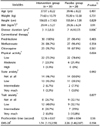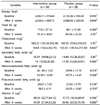1. Abid Mahdi E, Ali Mohamed L, Abass Hadi M. The relationship between lipid profile and inflammatory markers in patients with early rheumatoid arthritis. Iraqi Natl J Chem. 2012; 47:391–400.
2. Helmick CG, Felson DT, Lawrence RC, Gabriel S, Hirsch R, Kwoh CK, Liang MH, Kremers HM, Mayes MD, Merkel PA, Pillemer SR, Reveille JD, Stone JH. National Arthritis Data Workgroup. Estimates of the prevalence of arthritis and other rheumatic conditions in the United States. Part I. Arthritis Rheum. 2008; 58:15–25.

3. Monjamed Z, Razavian F. The impact of signs and symptoms on the quality of life in patients with rheumatoid arthritis referred to the hospitals of tehran university of medical sciences in year 2005. Qom Univ Med Sci J. 2007; 1:27–35.
4. Nurmohamed MT. Atherogenic lipid profiles and its management in patients with rheumatoid arthritis. Vasc Health Risk Manag. 2007; 3:845–852.
5. Dessein PH, Christian BF, Solomon A. Which are the determinants of dyslipidemia in rheumatoid arthritis and does socioeconomic status matter in this context? J Rheumatol. 2009; 36:1357–1361.

6. White D, Fayez S, Doube A. Atherogenic lipid profiles in rheumatoid arthritis. N Z Med J. 2006; 119:U2125.
7. Georgiadis AN, Papavasiliou EC, Lourida ES, Alamanos Y, Kostara C, Tselepis AD, Drosos AA. Atherogenic lipid profile is a feature characteristic of patients with early rheumatoid arthritis: effect of early treatment--a prospective, controlled study. Arthritis Res Ther. 2006; 8:R82.
8. Ohsaki Y, Shirakawa H, Hiwatashi K, Furukawa Y, Mizutani T, Komai M. Vitamin K suppresses lipopolysaccharide-induced inflammation in the rat. Biosci Biotechnol Biochem. 2006; 70:926–932.

9. Okamoto H. Vitamin K and rheumatoid arthritis. IUBMB Life. 2008; 60:355–361.

10. Geleijnse JM, Vermeer C, Grobbee DE, Schurgers LJ, Knapen MH, van der Meer IM, Hofman A, Witteman JC. Dietary intake of menaquinone is associated with a reduced risk of coronary heart disease: the Rotterdam Study. J Nutr. 2004; 134:3100–3105.

11. Sogabe N, Maruyama R, Baba O, Hosoi T, Goseki-Sone M. Effects of long-term vitamin K(1) (phylloquinone) or vitamin K(2) (menaquinone-4) supplementation on body composition and serum parameters in rats. Bone. 2011; 48:1036–1042.

12. Kawashima H, Nakajima Y, Matubara Y, Nakanowatari J, Fukuta T, Mizuno S, Takahashi S, Tajima T, Nakamura T. Effects of vitamin K2 (menatetrenone) on atherosclerosis and blood coagulation in hypercholesterolemic rabbits. Jpn J Pharmacol. 1997; 75:135–143.

13. Nagasawa Y, Fujii M, Kajimoto Y, Imai E, Hori M. Vitamin K2 and serum cholesterol in patients on continuous ambulatory peritoneal dialysis. Lancet. 1998; 351:724.

14. Kristensen M, Kudsk J, Bügel S. Six weeks phylloquinone supplementation produces undesirable effects on blood lipids with no changes in inflammatory and fibrinolytic markers in postmenopausal women. Eur J Nutr. 2008; 47:375–379.

15. Scott DL, Wolfe F, Huizinga TW. Rheumatoid arthritis. Lancet. 2010; 376:1094–1108.

16. Julian LJ. Measures of anxiety: State-Trait Anxiety Inventory (STAI), Beck Anxiety Inventory (BAI), and Hospital Anxiety and Depression Scale-Anxiety (HADS-A). Arthritis Care Res (Hoboken). 2011; 63:Suppl 11. S467–S472.

17. Hagströmer M, Oja P, Sjöström M. The International Physical Activity Questionnaire (IPAQ): a study of concurrent and construct validity. Public Health Nutr. 2006; 9:755–762.

18. Craig CL, Marshall AL, Sjöström M, Bauman AE, Booth ML, Ainsworth BE, Pratt M, Ekelund U, Yngve A, Sallis JF, Oja P. International physical activity questionnaire: 12-country reliability and validity. Med Sci Sports Exerc. 2003; 35:1381–1395.

19. Hazavehei SM, Asadi Z, Hassanzadeh A, Shekarchizadeh P. Comparing the effect of two methods of presenting physical education II course on the attitudes and practices of female students towards regular physical activity in Isfahan University of Medical Sciences. Iran J Med Edu. 2008; 8:121–131.
20. Wells G, Becker JC, Teng J, Dougados M, Schiff M, Smolen J, Aletaha D, van Riel PL. Validation of the 28-joint Disease Activity Score (DAS28) and European League Against Rheumatism response criteria based on C-reactive protein against disease progression in patients with rheumatoid arthritis, and comparison with the DAS28 based on erythrocyte sedimentation rate. Ann Rheum Dis. 2009; 68:954–960.

21. Ghaffarpour M, Houshyar Rad A, Kianfar H. Guideline for Household Measures, Conversion Coefficients and the Percent of Edible Food. Tehran: Publication of Agricultural Sciences;2000.
22. Ebina K, Shi K, Hirao M, Kaneshiro S, Morimoto T, Koizumi K, Yoshikawa H, Hashimoto J. Vitamin K2 administration is associated with decreased disease activity in patients with rheumatoid arthritis. Mod Rheumatol. 2013; 23:1001–1007.

23. Braam LA, Knapen MH, Geusens P, Brouns F, Vermeer C. Factors affecting bone loss in female endurance athletes: a two-year followup study. Am J Sports Med. 2003; 31:889–895.

24. Craciun AM, Wolf J, Knapen MH, Brouns F, Vermeer C. Improved bone metabolism in female elite athletes after vitamin K supplementation. Int J Sports Med. 1998; 19:479–484.

25. Gallagher ML. Intake: the nutrients and their metabolism. In : Mahan LK, Escott-Stump S, Raymond JL, editors. Krause's Food & the Nutrition Care Process. 13th ed. St. Louis (MO): Elsevier/Saunders;2012. p. 80–81.
26. Cordova CM, Schneider CR, Juttel ID, Cordova MM. Comparison of LDL-cholesterol direct measurement with the estimate using the Friedewald formula in a sample of 10,664 patients. Arq Bras Cardiol. 2004; 83:482–487. 76–81.
27. Asghari Jafarabadi M, Mohammadi SM. Statistical series: summarizing and displaying data. Iran J Diabetes Lipid Disord. 2013; 12:83–100.
28. Asghari Jafarabadi M, Mohammadi SM. Statistical series: introduction to statistical inference (Point estimation, confidence interval and hypothesis testing). Iran J Diabetes Lipid Disord. 2013; 12:173–192.
29. Asghari Jafarabadi M, Soltani A, Mohammadi SM. Statistical series: tests for comparing of means. Iran J Diabetes Lipid Disord. 2013; 12:265–291.
30. Takeuchi Y, Suzawa M, Fukumoto S, Fujita T. Vitamin K(2) inhibits adipogenesis, osteoclastogenesis, and ODF/RANK ligand expression in murine bone marrow cell cultures. Bone. 2000; 27:769–776.

31. Shea MK, Dallal GE, Dawson-Hughes B, Ordovas JM, O'Donnell CJ, Gundberg CM, Peterson JW, Booth SL. Vitamin K, circulating cytokines, and bone mineral density in older men and women. Am J Clin Nutr. 2008; 88:356–363.








 PDF
PDF ePub
ePub Citation
Citation Print
Print



 XML Download
XML Download